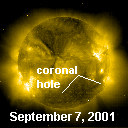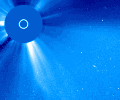|   SPACE WEATHER SPACE WEATHER
Current
Conditions
Solar Wind
velocity: 401.3 km/s
density:0.1 protons/cm3
explanation | more data
Updated: Today at 2247 UT
X-ray Solar Flares
6-hr max: M1 1920 UT Sep08
24-hr: M1 1920 UT Sep08
explanation | more data
Updated: Today at 2245 UT
Daily Sun: 07 Sep '01 
Sunspot group 9601 has a delta-class magnetic field that harbors energy for X-class flares. Active regions 9606 and 9608 have gamma-class magnetic fields that could be a source of M-class flares. Image credit: SOHO/MDI
The Far Side of the Sun
This holographic image reveals a large southern hemisphere sunspot on the far side of the Sun. Image credit: SOHO/MDI
Sunspot Number: 288
More about sunspots
Updated: 07 Sep 2001
Radio Meteor Rate
24 hr max: 30 per hr
Listen to the Meteor Radar!
Updated: 07 Sep 2001 Interplanetary Mag. Field
Btotal: 7.9 nT
Bz: 1.6 nT south
explanation | more data
Updated: Today at 2247 UT Coronal Holes:

This southern hemisphere coronal hole is not favorably positioned to send solar wind gusts toward Earth. Image credit: SOHO Extreme UV Telescope.
More about coronal holes
 SPACE WEATHER SPACE WEATHER
NOAA
Forecasts
Solar Flares: Probabilities for a medium-sized (M-class) or a major (X-class) solar flare during the next 24/48 hours are tabulated below.
Updated at 2001 Sep 08 2200 UT
| FLARE | 0-24 hr | 24-48 hr | | CLASS M | 75 % | 75 % | | CLASS X | 15 % | 15 % |
Geomagnetic Storms: Probabilities for significant disturbances in Earth's magnetic field are given for three activity levels: active, minor storm, severe storm
Updated at 2001 Sep 08 2200 UT Mid-latitudes | 0-24 hr | 24-48 hr | | ACTIVE | 15 % | 15 % | | MINOR | 05 % | 05 % | | SEVERE | 01 % | 01 % |
High latitudes | 0-24 hr | 24-48 hr | | ACTIVE | 20 % | 20 % | | MINOR | 10 % | 10 % | | SEVERE | 01 % | 01 % |

Web server provided by
VPS Hosting
| What's Up in Space -- 8 Sep 2001
Subscribe to Space Weather News!  BIG SUNSPOT: In recent days an impressive sunspot group has emerged near the Sun's southeastern limb. The sprawling complex stretches nearly 20 Earth diameters from end to end. Magnetograms of the region reveal twisted gamma-class magnetic fields that harbor energy for strong solar flares. BIG SUNSPOT: In recent days an impressive sunspot group has emerged near the Sun's southeastern limb. The sprawling complex stretches nearly 20 Earth diameters from end to end. Magnetograms of the region reveal twisted gamma-class magnetic fields that harbor energy for strong solar flares.
You can see these sunspots for yourself. But never look directly at the Sun! Use safe solar projection methods instead.  KAMIKAZE COMET: On Sept. 5th coronagraphs on board the Solar and Heliospheric Observatory recorded a bright comet (pictured right) disintegrating as it plunged toward the Sun. Amateur astronomer Sebastian Hönig spotted the "sungrazer" in online images at the SOHO web site, marking the 347th time someone has found a new comet by watching SOHO coronagraphs. SOHO-347, like most known sungrazing comets, is likely to be a fragment from a single giant comet that broke apart long ago. KAMIKAZE COMET: On Sept. 5th coronagraphs on board the Solar and Heliospheric Observatory recorded a bright comet (pictured right) disintegrating as it plunged toward the Sun. Amateur astronomer Sebastian Hönig spotted the "sungrazer" in online images at the SOHO web site, marking the 347th time someone has found a new comet by watching SOHO coronagraphs. SOHO-347, like most known sungrazing comets, is likely to be a fragment from a single giant comet that broke apart long ago.
WEB LINKS: NOAA FORECAST | GLOSSARY | SPACE WEATHER TUTORIAL | LESSON PLANS | BECOME A SUBSCRIBER | 
Potentially Hazardous Asteroids (PHAs) are space rocks larger than approximately 100m that can come closer to Earth than 0.05 AU. None of the known PHAs are on a collision course with our planet, although astronomers are finding new ones all the time.
On 8 Sep 2001 there were 318 known Potentially
Hazardous Asteroids Sep-Oct. 2001 Earth-asteroid encountersNotes: LD is a "Lunar Distance." 1 LD = 384,401 km, the distance between Earth and the Moon. 1 LD also equals 0.00256 AU. MAG is the visual magnitude of the asteroid on the date of closest approach. 
- PERSEIDS 2001: Perseid watchers on August 12th spotted meteors, auroras, and a disintegrating Russian rocket! [gallery]
- MORNING PLANETS: In July and Aug. 2001, the Moon, Jupiter, Saturn, Venus, and Mercury put on a dazzling early-morning sky show. [gallery]
- C/2001 A2 (LINEAR): This volatile comet is still visible through small telescopes as it recedes from Earth. [gallery]
- ECLIPSE SAFARI: Onlookers cried out in delight on June 21, 2001, when the Moon covered the African Sun, revealing the dazzling corona. [gallery]
- TOTAL LUNAR ECLIPSE: On Jan. 9, 2001, the full Moon glided through Earth's copper-colored shadow. [gallery]
- CHRISTMAS ECLIPSE: Sky watchers across North America enjoyed a partial solar eclipse on Christmas Day 2000 [gallery]
- LEONIDS 2000: Observers around the globe enjoyed three predicted episodes of shooting stars. [gallery]
 July 27, 2001: Meteorites Don't Pop Corn -- A fireball that dazzled Americans on July 23rd probably didn't scorch any cornfields, contrary to widespread reports. June 12, 2001: The Biggest Explosions in the Solar System -- NASA's HESSI spacecraft aims to unravel an explosive mystery: the origin of solar flares. Feb. 21, 2001: Nature's Tiniest Space Junk -- Using an experimental radar, NASA scientists are monitoring tiny but hazardous meteoroids that swarm around our planet. Feb. 15, 2001: The Sun Does a Flip -- NASA scientists who monitor the Sun say our star's enormous magnetic field is reversing -- a sure sign that solar maximum is here. Jan. 25, 2001: Earth's Invisible Magnetic Tail -- NASA's IMAGE spacecraft, the first to enjoy a global view of the magnetosphere, spotted a curious plasma tail pointing from Earth toward the Sun. Jan. 4, 2001: Earth at Perihelion -- On January 4, 2001, our planet made its annual closest approach to the Sun. Dec. 29, 2000: Millennium Meteors -- North Americans will have a front-row seat for a brief but powerful meteor shower on January 3, 2001. Dec. 28, 2000: Galileo Looks for Auroras on Ganymede -- NASA's durable Galileo spacecraft flew above the solar system's largest moon this morning in search of extraterrestrial "Northern Lights" Dec. 22, 2000: Watching the Angry Sun -- Solar physicists are enjoying their best-ever look at a Solar Maximum thanks to NOAA and NASA satellites. MORE SPACE WEATHER HEADLINES |

